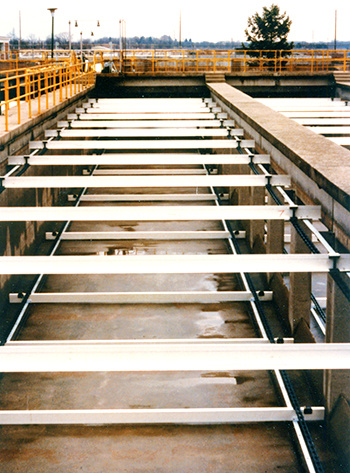Case Study: Fiberglass Components Setting New Standard For Sludge Collector Systems
 Jeffrey Division of Dresser Industries Inc. in Woodruff, South Carolina, manufactures a composite link sludge collector system for wastewater treatment. This system includes fiberglass flights and solid rod, pultruded by Strongwell. The system is lightweight, corrosion resistant, maintenance-free and generally has a longer and more cost effective service life than steel or wood collector systems.
Jeffrey Division of Dresser Industries Inc. in Woodruff, South Carolina, manufactures a composite link sludge collector system for wastewater treatment. This system includes fiberglass flights and solid rod, pultruded by Strongwell. The system is lightweight, corrosion resistant, maintenance-free and generally has a longer and more cost effective service life than steel or wood collector systems.
Jeffrey’s fiberglass flight features maximum rigidity with less than 1/4" deflection in a 24-foot flight and a modulus of elasticity in excess of 3-1/2 million psi. The strong, rigid flight, with its 2" scraping lip, resists bowing when pulled along the chain conveyor, dragging sludge through the system. These benefits combine to keep the basin floor clear of sludge. Attachment links connect the flight to the chain, supported by a molded flight bracket to provide additional strength.
The flights are manufactured in both a standard grade resin system for general wastewater applications and a premium grade resin system for highly corrosive environments. Solid fiberglass rods connect the chain links at critical stress points.
EXTREN® 3" x 3" x 3/8" angle is used in the system as runways that run lengthwise to the horizontal flights. Standard 10" x 2-3/4" x 1/4" channel is used as clips in the flight assembly.
| TECHNICAL DATA |
|---|
| Product: Fiberglass Flight Channel |
| Process: Pultrusion |
| Materials: Glass rovings, glass mat, white isophthalic resin |
| Sizes: Flight (various lengths)
EXTREN® Structural Shapes:
|
| For: Jeffrey Manufacturing |
“The fiberglass sludge collector system was first introduced to the market in 1979 by Jeffrey. Since that time the demand for this system has been steadily increasing in preference to steel and wood systems,” said Jeffrey Purchasing Agent, Bill Laster. “Fiberglass flights are now the standard in the industry in most retrofits and new installations. You just can’t beat it for low maintenance, ease of installation and long service life. The flights are drilled and routed at the Bristol plant for faster installation when it reaches the job site. We’ve never retrofitted a composite sludge collector system we’ve installed and, as far as I know, the first one we installed has been trouble-free and is still in operation.”